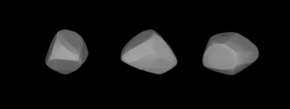162 Laurentia is a large and dark main-belt asteroid that was discovered by the French brothers Paul Henry and Prosper Henry on 21 April 1876, and named after Joseph Jean Pierre Laurent, an amateur astronomer who discovered asteroid 51 Nemausa.
An occultation by Laurentia was observed from Clive, Alberta on 21 November 1999.
Photometric observations of this asteroid from multiple observatories during 2007 gave a light curve with a period of 11.8686 ± 0.0004 hours and a brightness variation of 0.40 ± 0.05 in magnitude. This is in agreement with previous studies in 1994 and 2007.
References
- Noah Webster (1884) A Practical Dictionary of the English Language
"Laurentian". Oxford English Dictionary (Online ed.). Oxford University Press. (Subscription or participating institution membership required.) - ^ Yeomans, Donald K., "162 Laurentia", JPL Small-Body Database Browser, NASA Jet Propulsion Laboratory, retrieved 12 May 2016.
- ^ Fienga, A.; Avdellidou, C.; Hanuš, J. (February 2020). "Asteroid masses obtained with INPOP planetary ephemerides". Monthly Notices of the Royal Astronomical Society. 492 (1). doi:10.1093/mnras/stz3407.
- ^ Oey, Julian; Krajewski, Ric (June 2008), "Lightcurve Analysis of Asteroids from Kingsgrove and Other Collaborating Observatories in the First Half of 2007", The Minor Planet Bulletin, vol. 35, no. 2, pp. 47–48, Bibcode:2008MPBu...35...47O.
External links
- 162 Laurentia at AstDyS-2, Asteroids—Dynamic Site
- 162 Laurentia at the JPL Small-Body Database

| Minor planets navigator | |
|---|---|
| Small Solar System bodies | |||||||
|---|---|---|---|---|---|---|---|
| Minor planets |
| ||||||
| Comets | |||||||
| Other | |||||||
This article about an S-type asteroid native to the asteroid belt is a stub. You can help Misplaced Pages by expanding it. |
